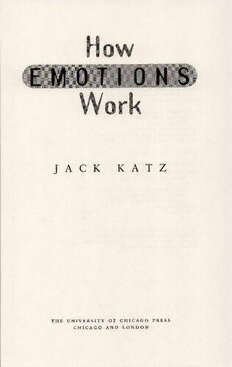
How Emotions Work PDF
Preview How Emotions Work
How Work KATZ JACK THE UNIVERSITY OF CHICAGO PRESS CHICAGO AND LONDON JACK KATZ is professor of sociology at the University of California, Los Angeles, and author olPoor People's Lawyers in Transition (1982) and Sed.atctions of Critne: Moral and Sensual Attraaions in Doing Euil (19881. The University of Chicago Press, Chicago 60537 The University of Chicago Press, Ltd., London @ t999 by Jack Katz AII rights reserved. Published 1999 Printed in the United States of America 08 07 06 05 04 03 02010099 123 4 5 ISBN: 0-22642599-1 (cloth) Library of Congress Cataloging-in-Publication Data Kau,lack, 1944- How emotions work / Jack Katz. p. cm. Includes bibliographical references and index. ISBN 0-226-42599-1 (cloth: alk. paper) 1. Emotions-Social aspects, L Title. BF531.K38 1999 752.4-dAt 99-32675 CP @ The paper used in this publication meets the minimum requirements of the American National Standard for Information Sciences-Permanence of Paper for Printed Library Materials, ANSI 239.48-1992. To my chi.ld.ren, in the order in which they began shaping the emotions of my everyday life: Zac, ktty, Ric, and Alex. And n Elena, with whom, for trventy years now, the metamorphoses have never been mundane. Ve think of ourselves as so intimately entwined in bodily life that a man is a complex unity-body and mind. But the body is part of the external world, continuous with it. In fact, it is just as much part of nature as anything else there-a river, or a mountain, or a cloud. Also, if we are fussily exact, we cannot define where a body begins and where external nature ends. North l7hitehead, Science and the Modern World -Alfred [E]ven questions about gods saving us can be brought down to earth and must finally be settled . . . by looking to the extraordi- narily subtle and varied way our everyday practices actually work to give us an understanding of what it means for us and everything else to be. Dreyfus and Harrison Hall, Heidegger: A Critical -Hubert Reader The object . . . [is] to describe the animation of the human body, not in terms of the descent into it of pure consciousness or reflec- tion, but as a metamorphosis of life, and the body as the "body o/the spirit" (Val6ry). Merleau-Ponty, Tbetnes from the Lectures at the -Maurice Collige de France, 1952-1950 CONTENTS Acknoutledgments xl Introduction 1 L.A. one Pissed Off in 18 Mirrors two Families and Funny 87 Moments three Shameful 142 Crying? tour What Is 175 tog and tugue An Introduaion to Two Cryings 223 Whining t ive An Episode of 229 six Crying in the Whirlpool 274 A Murderer Breaks Down und.er Police Interrogation seve n Mundane Metamorphoses 309 Nofes 345 References 381 lnd.ex 393 tx t ACKNOWLEDGMENTS Questions from audiences, some anticipated and some unexpected, some uttered and others emphatically implied through polite but la- bored restraint, were indispensable for sustaining and repeatedly redi- recting this proiect over a period of many years. My perspective on emotions was first worked out in interaction with students in seminar discussions. I am very grateful for the patient collaboration of several cohorts of Ph.D. students at UCLA, and to Prof. Alain Coulon, who, after wandering into my seminar in Los Angeles, set up a seminar course at the University of Paris VII! where I first tried out a format for this book. For other challenging opportunities, I would like to thank Keith Oatley and a session in l(tirzburg, Germany, of the Inter- national Society for Research on Emotions; George Psathas and a meeting of the M.I.D.A.S. society at Harvard; Martin Jay and the "Ex- perience" group of the German and European Study Center at Berke- iey; and several sessions organized through the University of Lund, Sweden, by Malin Akerstrom, Kaisa Ekholm Friedman, and Jonathan Friedman. I was fortunate to receive comments on drafts of one or more sec- tions from Howard S. Becker, Alain Coulon, Jeff Coulter, Lori Cro- nyn, Mitchell Duneier, Robert M. Emerson, Michael Flaherty, Robert Garot, Calin Goina, John Heritage, David Johnson, Gail Kligman, Margarethe Kusenbach, Melvin Lansky, Richard Leo, Dan Marks, Aundra Saa Meroe, Keith Oatley, Melvin Pollner, Fred Prichard, Su- zanne Retzinger, Ted Sarbin, Thomas Scheff, Melvin Seeman, Lakshmi 'sracquant Srinivas, and Diane Vaughan. Loic digested the whole manuscript and offered extraordinarily incisive criticism and very us- able advice. I thank Ricardo Halpern for producing the video images in chapter 2; Scott Galbraith for the illustrations in chapter 5, which he made from video stills; and both scott Galbraith and Naomi Fuji- moto for cheerful and painstaking research assistance. The Academic xl xn Acknowledgments senate at ucLA helped with modest bur essential research funds. Be- cause of Doug Mitchell's enthusiasm, Michael Koplow,s attention to detail, and Martin $7hite's work on the index, it has been a pleasure to make the book with Chicago. My appreciation for contributions of data is expressed in the chap- ters, but because of the need to make the subjects anonymous, my biggest debt cannot be properly paid. In a sense my job has been simply to haul barriers of artificial ideas and inappropriate methods o,ri of the way so that we can see the intimate innovations that peopre make in their everyday lives. This book fails if it is not obvious that its cre- ativity has been ripped off from its subjects. For permission to reprint parts of chapters 2 and 3 that were previ- ously published, I thank, respecively, the American Journal of Sociol- ogy andAnalytic Press. For permission ro use rhe photograph by Andr6 Kert6sz in chapter 2, I thank the Kert6sz estate and its curator, Robert Gurbo.
